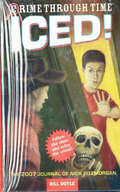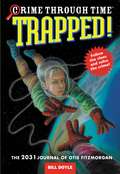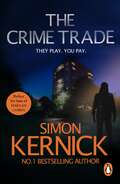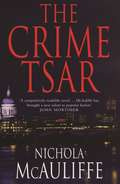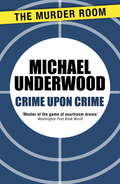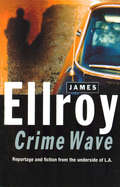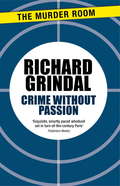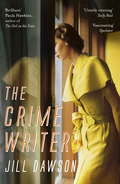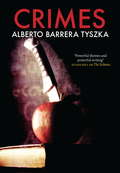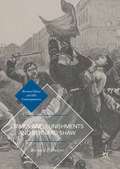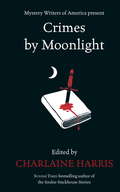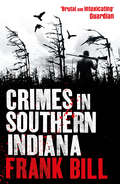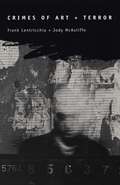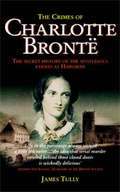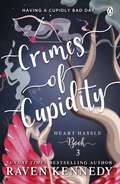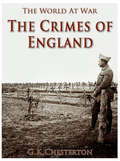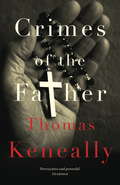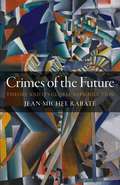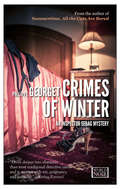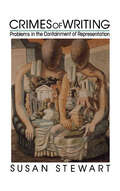- Table View
- List View
Crime Through Time #5: The 2007 Journal of Nick Fitzmorgan (Crime Through Time Ser. #5)
by Bill DoyleEach book in the Crime Through Time series is hosted by a different child member of the famous Fitzmorgan detective family. While the young sleuth unravels a fictional mystery, readers learn about the real historical setting and actual crime-solving methods from the different eras. In sidebar activities, readers take on the role of assistant, helping to crack the case. Breathtakingly suspenseful but never violent and always age-appropriate, the books read like private investigative journals, with photos, maps, news clippings and crime scene sketches.In book 5, set in 2007, Nick Fitzmorgan unexpectedly returns home early from detective training camp, only to find his screenwriter father vanished and the house in disarray. The house isn't just messy, though: it's carefully set up with clues that will lead Nick all the way to Everest, and his father's rescue.
Crime Through Time #6: The 2031 Journal of Otis Fitzmorgan (Crime Through Time Ser. #6)
by Bill DoyleEach book in the Crime Through Time series is hosted by a different child member of the famous Fitzmorgan detective family. While the young sleuth unravels a fictional mystery, readers learn about the real historical setting and actual crime-solving methods from the different eras. In sidebar activities, readers take on the role of assistant, helping to crack the case. Breathtakingly suspenseful but never violent and always age-appropriate, the books read like private investigative journals, with photos, maps, news clippings and crime scene sketches.In book 6, set in 2031, Otis Fitzmorgan finds himself in the middle of an evil art fraud mystery in space. On his way back to earth via the new space elevator Otis is forced to use his outlawed private detective skills to get to the bottom of the mystery that is threatening to kill all of those on board.
The Crime Trade: (Tina Boyd 1) (Tina Boyd #1)
by Simon KernickStegs Jenner has always lived on the edge.No ordinary cop, he's never happier than when he's working undercover, consorting with criminals and fighting to bring them to justice. But suspicion falls on him when he strikes out on his own and the operation he's involved in goes horribly wrong.DI John Gallan and DS Tina Boyd are called in to investigate.What they cannot know is that their enquiries will take them both into the heart of one of London's most notorious criminal gangs - and one of them into the rifle sights of the enemy.
The Crime Tsar
by Nichola McAuliffePolice Chief Constable Tom Shackleton is ambitious to reach the top of his profession, but no one is more ambitious for his future than his wife. Jenni Shackleton looks every inch the consort to a powerful man. Striking and groomed to gleam in any crowd, she is connected through her own job in journalism to the right people to further Tom's career - or so she thinks. She is also unscrupulous: Jenni Shackleton will stop at nothing to get what she wants. Next door and down on her luck is Lucy, whose husband Gary is physically failing with MS, so that she finds it necessary to act as housekeeper to Jenni, formerly just a friend but now also an employer, who somehow can't help patronising Lucy for wielding the household duster. What Jenni is too vain to see is that her comparatively frumpish housekeeper friend has everything that her husband actually finds desirable in a woman. In Jenni's view of her horizon, the only blot is Tom's natural rival, Geoff Carter, a man with just too much Oxbridge polish and connection with the government to allow her to sleep well at night. But as Jenni soon discovers, there is a drug for everything. Threads of classical tragedy run through this modern drama of power, cunning sex and ambition. Nichola McAuliffe directs it all with style, skill and at a thunderous pace.
Crime Upon Crime (Rosa Epton #10)
by Michael UnderwoodNot much was known about Arthur Kedby in the West End Club that he frequented. 'He doesn't look much like a secret agent,' remarked one member, but in general that was what he was believed to be. But Kedby is a blackmailer, and not even a very successful one; his great success lies in the fact that he has never been caught.Then he recognises the face of a club guest - a face he has seen before. And all at once Kedby has an opportunity to practise his skills at a level that might just furnish him with a pension ...
Crime Wave: Reportage And Fiction From The Underside Of L. A. (Punto De Lectura Ser.)
by James EllroyReportage and fiction from the underside of LA. James Ellroy is a unique and powerful writer with a tough and explosive voice. His obsession with the dark side of L. A. is personal and vital, triggered by the murder of his mother when he was ten. This defining event spawned an early addiction to paperback crime novels, and Ellroy's own writing is saturated in an often violent underworld of bent cops, politicians, stars, sleeze and rumour. Ellroy exploits memory, history, fact and fiction with relentless energy and panache. What emerges is an intense, mythical version of tinseltown in the second half of the twentieth century.
Crime Without Passion (Inspector Gautier Series)
by Richard GrindalAn aristocratic young woman, Denise de Richemont, has murdered an important journalist, Jaques Le Tellier. She is acquitted by a sympathetic jury when she confesses it to be a crime of passion - revenge for the journalist's indiscreet revelation of his mistress' sordid family secrets. But the real reason why Mademoiselle de Richemont killed Le Tellier is far more sinister, and Inspector Gautier pursues the case from the haute monde of fashionable Paris to the seething and dangerous slums, determined to solve the mystery behind the murder.
The Crime Writer: A Novel
by Jill Dawson'Brilliant'Paula HawkinsIn 1964, the eccentric American novelist Patricia Highsmith is hiding out in a cottage in Suffolk, to concentrate on her writing and escape her fans. She has another motive too - a secret romance with a married lover based in London. Unfortunately it soon becomes clear that all her demons have come with her. Prowlers, sexual obsessives, frauds, imposters, suicides and murderers: the tropes of her fictions clamour for her attention, rudely intruding on her peaceful Suffolk retreat. After the arrival of Ginny, an enigmatic young journalist bent on interviewing her, events take a catastrophic turn. Except, as always in Highsmith's troubled life, matters are not quite as they first appear . . .Masterfully recreating Highsmith's much exercised fantasies of murder and madness, Jill Dawson probes the darkest reaches of the imagination in this novel - at once a brilliant portrait of a writer and an atmospheric, emotionally charged, riveting tale.
Crimen y castigo
by Fédor DostoievskyEl parricidio es para Freud el crimen capital y primordial tanto de la humanidad como del individuo. Esto queda de manera clara y contundente en los hermanos Karamazov, el crimen para desaparecer al padre absoluto, que todo lo puede, y dar lugar a un padre que nombra, un padre que orienta pero que no es destino, no es meta, un padre que no se sostiene y del cual surge el deseo. Otro texto fundamental es Crimen y Castigo, otra demostración contundente de lo que se juega en el sujeto en esa relación necesaria, definitiva y peligrosa con la madre. Consideradas las dos grandes novelas de Fiodor Dostoievsky, estos textos nos remiten al sujeto, a su malestar estructural en la cultura. Ambos textos revisten carácter universal.
Crimes
by Alberto Barrera TyszkaUnexplained blood stains appear in a young couple's apartment; a disembodied hand is found in a rubbish dump; political prisoners resort to horrific measures in order to make a point.In this brilliant new collection of stories, Alberto Barrera Tyszka casts an eye on the violence that afflicts Latin America, and in particular its intimate effects on the individuals who suffer and inflict it.Mixing the surreal with the quotidian, the banal with the unspeakable, Tyszka has created a fragmentary panorama of man's misdeeds against his own kind. These windingly elliptical stories are ceaselessly surprising, and will bury themselves into your subconscious long after the final page is turned.
Crimes and Punishments and Bernard Shaw
by Bernard F. DukoreThis book analyzes the interaction of crimes, punishments, and Bernard Shaw in the nineteenth and twentieth centuries. It explores crimes committed by professional criminals, nonprofessional criminals, businessmen, believers in a cause, the police, the Government, and prison officials. It examines punishments decreed by judges, juries, colonial governors, commissars, and administered by the police, prison warders, and prison doctors. It charts Shaw's view of crimes and punishments in dramatic writings, non-dramatic writings, and his actions in real life. This book presents him in the context of his contemporaries and his world, inviting readers to view crimes and punishments in their context, history, and relevance to his ideas in and outside his plays, plus the relevance of his ideas to crimes and punishments in life.
Crimes and Punishments and Bernard Shaw
by Bernard F. DukoreThis book analyzes the interaction of crimes, punishments, and Bernard Shaw in the nineteenth and twentieth centuries. It explores crimes committed by professional criminals, nonprofessional criminals, businessmen, believers in a cause, the police, the Government, and prison officials. It examines punishments decreed by judges, juries, colonial governors, commissars, and administered by the police, prison warders, and prison doctors. It charts Shaw's view of crimes and punishments in dramatic writings, non-dramatic writings, and his actions in real life. This book presents him in the context of his contemporaries and his world, inviting readers to view crimes and punishments in their context, history, and relevance to his ideas in and outside his plays, plus the relevance of his ideas to crimes and punishments in life.
Crimes by Moonlight: Mysteries From The Dark Side
by Charlaine HarrisNighttime is the perfect time for the perfect crime. #1 SUNDAY TIMES and NEW YORK TIMES bestselling author Charlaine Harris edits and contributes an all-new story - set in her Sookie Stackhouse universe, now filmed as TRUE BLOOD - to this anthology from the Mystery Writers of America.Other authors include:Steve Brewer, Dana Cameron, Max Allan Collins and Mickey Spillane, Barbara D'Amato, Brendan DuBois, Terrie Farley Moran, Jack Fredrickson, Parnell Hall, Carolyn Hart, S. W. Hubbard, Toni L. P. Kelner, Lou Kemp, William Kent Kreuger, Harley Jane Kozak, Margaret Maron, Martin Meyers, Jeffrey Somers, Elaine Viets and Mike Wiecek
Crimes in Southern Indiana: Stories
by Frank BillWelcome to Heartland America circa right about now, when the union jobs and family farms that kept the white on the picket fences have given way to meth labs, backwoods gunrunners, and bare-knuckle brawling. Frank Bill's Southern Indiana is haunted by a deep, abiding sense of place, and his people are men and women pressed to the brink - and beyond. They are survivors, and in Frank Bill's hands, their stories bristle with noir energy.
Crimes of Art and Terror
by Frank Lentricchia Jody McAuliffeDo killers, artists, and terrorists need one another? In Crimes of Art and Terror, Frank Lentricchia and Jody McAuliffe explore the disturbing adjacency of literary creativity to violence and even political terror. Lentricchia and McAuliffe begin by anchoring their penetrating discussions in the events of 9/11 and the scandal provoked by composer Karlheinz Stockhausen's reference to the destruction of the World Trade Center as a great work of art, and they go on to show how political extremism and avant-garde artistic movements have fed upon each other for at least two centuries. Crimes of Art and Terror reveals how the desire beneath many romantic literary visions is that of a terrifying awakening that would undo the West's economic and cultural order. This is also the desire, of course, of what is called terrorism. As the authority of writers and artists recedes, it is criminals and terrorists, Lentricchia and McAuliffe suggest, who inherit this romantic, destructive tradition. Moving freely between the realms of high and popular culture, and fictional and actual criminals, the authors describe a web of impulses that catches an unnerving spirit. Lentricchia and McAuliffe's unorthodox approach pairs Dostoevsky's Crime and Punishment with Martin Scorsese's King of Comedy and connects the real-life Unabomber to the surrealist Joseph Cornell and to the hero of Bret Easton Ellis's bestselling novel American Psycho. They evoke a desperate culture of art through thematic dialogues among authors and filmmakers as varied as Don DeLillo, Joseph Conrad, Francis Ford Coppola, Jean Genet, Frederick Douglass, Hermann Melville, and J. M. Synge, among others. And they conclude provocatively with an imagined conversation between Heinrich von Kleist and Mohamed Atta. The result is a brilliant and unflinching reckoning with the perilous proximity of the impulse to create transgressive art and the impulse to commit violence.
Crimes of Art and Terror (Studies In Communication, Media, And Public Opinion Ser.)
by Frank Lentricchia Jody McAuliffeDo killers, artists, and terrorists need one another? In Crimes of Art and Terror, Frank Lentricchia and Jody McAuliffe explore the disturbing adjacency of literary creativity to violence and even political terror. Lentricchia and McAuliffe begin by anchoring their penetrating discussions in the events of 9/11 and the scandal provoked by composer Karlheinz Stockhausen's reference to the destruction of the World Trade Center as a great work of art, and they go on to show how political extremism and avant-garde artistic movements have fed upon each other for at least two centuries. Crimes of Art and Terror reveals how the desire beneath many romantic literary visions is that of a terrifying awakening that would undo the West's economic and cultural order. This is also the desire, of course, of what is called terrorism. As the authority of writers and artists recedes, it is criminals and terrorists, Lentricchia and McAuliffe suggest, who inherit this romantic, destructive tradition. Moving freely between the realms of high and popular culture, and fictional and actual criminals, the authors describe a web of impulses that catches an unnerving spirit. Lentricchia and McAuliffe's unorthodox approach pairs Dostoevsky's Crime and Punishment with Martin Scorsese's King of Comedy and connects the real-life Unabomber to the surrealist Joseph Cornell and to the hero of Bret Easton Ellis's bestselling novel American Psycho. They evoke a desperate culture of art through thematic dialogues among authors and filmmakers as varied as Don DeLillo, Joseph Conrad, Francis Ford Coppola, Jean Genet, Frederick Douglass, Hermann Melville, and J. M. Synge, among others. And they conclude provocatively with an imagined conversation between Heinrich von Kleist and Mohamed Atta. The result is a brilliant and unflinching reckoning with the perilous proximity of the impulse to create transgressive art and the impulse to commit violence.
The Crimes of Charlotte Bronte: The Secret History of the Mysterious Events at Haworth
by James TullyNoted criminologist James Tully became fascinated by inconsistencies he found in the accounts of the lives and deaths of the Brontes. So dark and unexpected were the results of his searches, he decided to tell the story in the form of a novel. He has created a controversial and compelling account of this most famous Victorian family.
Crimes of Cupidity: The sizzling romance from the bestselling author of The Plated Prisoner series (Heart Hassle #3)
by Raven KennedyIs falling in love multiple times really such a crime?This cupid says no.Emelle used to be just a stupid cupid helping others fall in love (or not) and living a loveless life.Everything changed when she went to the fae realm and was no longer invisible. Her sole goal was to find love for herself, and she did. With four fae men.Too bad she found trouble too.She's somehow become an accidental spy for the kingdom's rebels, and there's a war brewing in the realm.All this cupid really wants to do is spread a bit of love . . . but she'll have to spread a bit of fight first.Good thing there's nothing a cupid will fight harder for than love.Crimes of Cupidity is Book Three in the fun, addictive and sexy Heart Hassle series
The Crimes of England: Revised Edition Of Original Version (The World At War)
by G. K. ChestertonGilbert Keith Chesterton,(29 May 1874 – 14 June 1936) better known as G. K. Chesterton, was an eng writer, lay theologian, poet, philosopher, dramatist, journalist, orator, literary and art critic, biographer, and Christian apologist. Chesterton is often referred to as the "prince of paradox." Time magazine, in a review of a biography of Chesterton, observed of his writing style: "Whenever possible Chesterton made his points with popular sayings, proverbs, allegories—first carefully turning them inside out." G.K. Chesterton's “The Crimes of England” is his response to the Great War in which he holds his own nation to account - a move which might be considered risky. Except, of course, that most of the crimes he details turn out to be England’s past alliances with and sympathies towards gery in general and Prussia in particular. (Excerpt from Wikipedia)
Crimes of the Father: A Novel
by Thomas KeneallyThomas Keneally pulls no punches in this powerful novel about the Catholic Church's attempts to cover up cases of child abuse, and a priest who decides to help its innocent victims' fight to be heard.Expelled from the archdiocese of Sydney as a young priest for his outspoken views on the Vietnam War, Father Frank Docherty returns to Australia in 1996 to speak at a conference on paedophilia within the Catholic Church. He had hoped to spend time with his mother and old friends. Instead, he finds himself caught up in the cases of two people who claim to have been sexually abused by an eminent Sydney cleric - one the son of Docherty's former parishioner, the other a former nun. And the cleric in question is brother to the woman Docherty fell in love with many years before. If the accusations are true, the consequences for many will be devastating, but Docherty has to follow his conscience. In this riveting, profoundly thoughtful novel, Thomas Keneally draws on his own experience as an ex-seminarian to bring alive matters of faith, celibacy, perversion and marriage. Portraying the Catholic Church at a pivotal moment, he shows that its prevarications and cover-ups wreaked terrible damage not only on innocents but on itself, with toxic repercussions to this day.
Crimes of the Future: Theory and its Global Reproduction
by Jean-Michel RabatéThe decade since the publication of Jean-Michel Rabaté's controversial manifesto The Future of Theory saw important changes in the field. The demise of most of the visible French or German philosophers, who had produced texts that would trigger new debates, then to be processed by Theory, has led to drastic revisions and starker assessments. Globalization has been the most obvious factor to modify the selection of texts studied. During the twentieth century, Theory incorporated poetics, rhetorics, aesthetics and linguistics, while also opening itself to continental philosophy. What has changed today? The knowledge that we live in a de-centered world has destabilized the primacy granted to a purely Western canon. Moreover, much of contemporary theory remains highly allusive and this is often baffling for students. Theory keeps recycling itself, producing authentic returns of basic theses, terms and concepts. Canonical modern theorists often return to classical texts, as those of Plato, Kant, Hegel, Nietzsche. And now we want to know: what is new?Crimes of the Future explores the past, present and potential future of Theory.
Crimes of the Future: Theory and its Global Reproduction
by Jean-Michel RabatéThe decade since the publication of Jean-Michel Rabaté's controversial manifesto The Future of Theory saw important changes in the field. The demise of most of the visible French or German philosophers, who had produced texts that would trigger new debates, then to be processed by Theory, has led to drastic revisions and starker assessments. Globalization has been the most obvious factor to modify the selection of texts studied. During the twentieth century, Theory incorporated poetics, rhetorics, aesthetics and linguistics, while also opening itself to continental philosophy. What has changed today? The knowledge that we live in a de-centered world has destabilized the primacy granted to a purely Western canon. Moreover, much of contemporary theory remains highly allusive and this is often baffling for students. Theory keeps recycling itself, producing authentic returns of basic theses, terms and concepts. Canonical modern theorists often return to classical texts, as those of Plato, Kant, Hegel, Nietzsche. And now we want to know: what is new?Crimes of the Future explores the past, present and potential future of Theory.
Crimes of Winter: An Inspector Sebag Mystery (The\inspector Sebag Mysteries Ser. #3)
by Philippe GeorgetCrime, suspense, and marital woes.This winter is going to be a rough one for Gilles Sebag, a police inspector in the sleepy French seaside town of Perpignan. After many long months of doubt, he has discovered the terrible truth: Claire has been cheating on him. Vacillating between depression, whisky, and insomnia, he buries himself in work in an attempt to forget the ugly realization that he has been betrayed. But his investigations lead him inexorably toward other tragedies: a woman murdered in a hotel, a depressed man who throws himself from the roof of his building, another who threatens to blow up the neighborhood.Whether it be by chance or due to Murphy’s law, Perpignan seems to be suffering from a veritable epidemic of crimes of passion. Adultery is everywhere! And each betrayal leads to another dramatic crime.Sebag, the protagonist of Summertime, All the Cats Are Bored and Autumn, All the Cats Return, has an unparalleled ability to slip into the skin of his suspects and solve apparently unsolvable crimes. But though an unnaturally skilled investigator, he is unlucky in love. He is a perfect protagonist for the coastal French town of Perpignan, which is almost everything except what it seems.
Crimes of Writing: Problems in the Containment of Representation
by Susan StewartFrom the origins of modern copyright in early eighteenth-century culture to the efforts to represent nature and death in postmodern fiction, this pioneering book explores a series of problems regarding the containment of representation. Stewart focuses on specific cases of "crimes of writing"--the forgeries of George Psalmanazar, the production of "fakelore," the "ballad scandals" of the eighteenth and nineteenth centuries, the imposture of Thomas Chatterton, and contemporary legislation regarding graffiti and pornography. In this way, she emphasizes the issues which arise once language is seen as a matter of property and authorship is viewed as a matter of originality. Finally, Stewart demonstrates that crimes of writing are delineated by the law because they specifically undermine the status of the law itself: the crimes illuminate the irreducible fact that law is written and therefore subject to temporality and interpretation.
